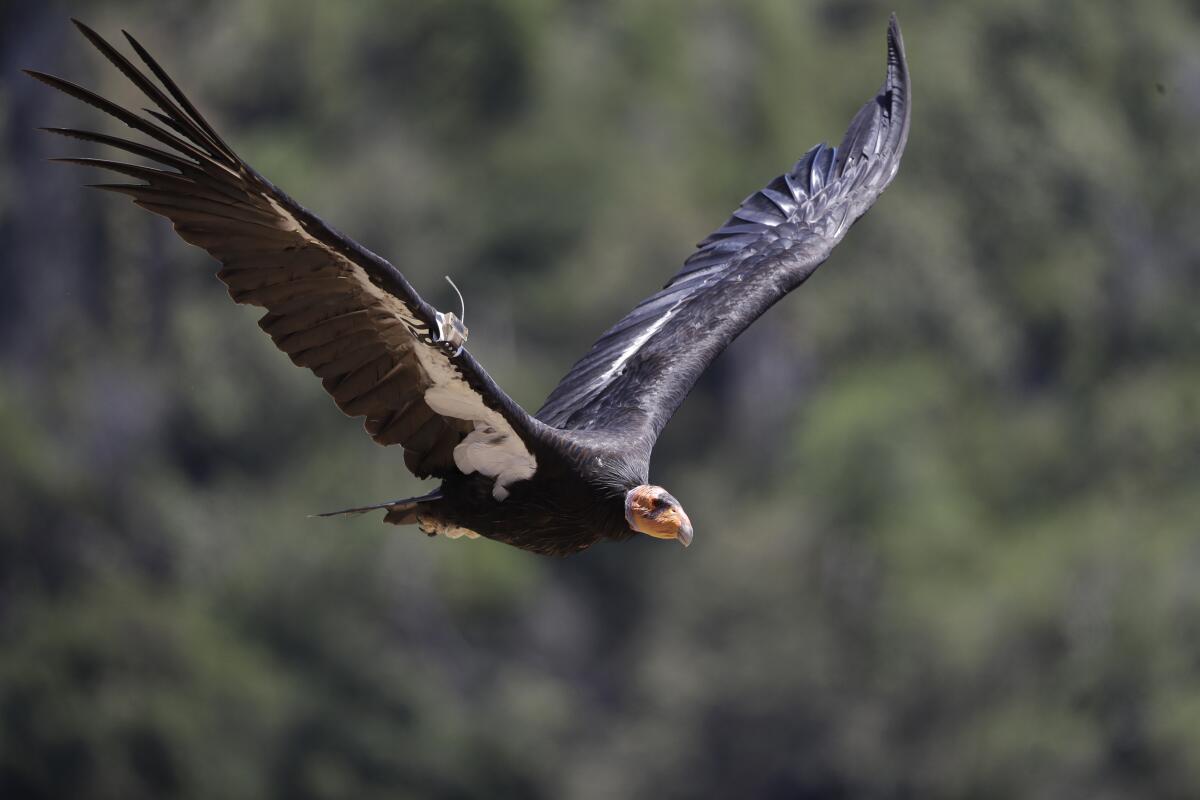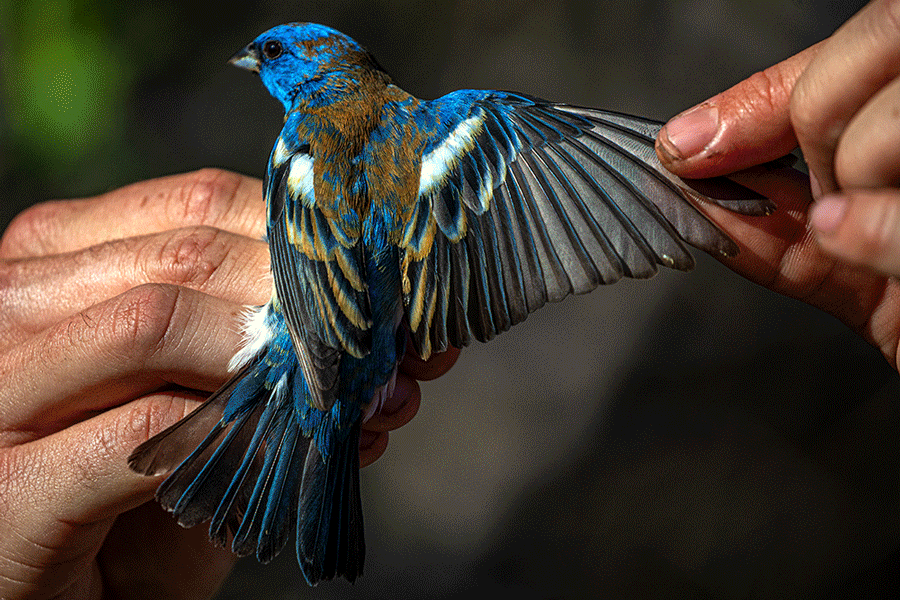California condors barely escaped extinction decades ago. Avian flu could change that

Famed for its bald, leathery visage and astonishing wingspan, the federally endangered California condor symbolizes both a species on the brink of extinction and a thundering success story for conservationists.
Just 22 condors existed when the U.S. Fish and Wildlife Service began a captive breeding effort in the early 1980s. Today, there are 183 in California and 541 on the planet.
Now, however, the majestic scavengers are facing a biological catastrophe they may not be able to overcome.
Federal wildlife officials have confirmed that an outbreak of avian influenza has killed 21 condors in Arizona and Utah since early March. That’s nearly 20% of the 116 condors that were patrolling the skies above Grand Canyon and Zion National Parks.
Now, the Fish and Wildlife Service and its conservation partners are scrambling to devise emergency strategies to protect the remaining condors from contracting a virus that has already killed hundreds of millions of poultry and untold numbers of wild birds around the world, according to a recent World Economic Forum report.
The whiplash change from extreme drought to epic snowpack is having very different outcomes for different species throughout California.
“We’re reevaluating multiple aspects of our condor recovery program to keep it moving forward,” said Ashleigh Blackford, California condor recovery coordinator for the U.S. Fish and Wildlife Service. “But the challenge is this: How do we implement new strategies without doing more harm than good?”
Avian influenza has been around for years, but this particular strain is lethal to wild birds in a way no other strain has been, Blackford said. “It’s a puzzle we are trying to get through without triggering setbacks.”
That won’t be easy. Many of the strategies under consideration are untested and conflict with programs that have made condors largely reliant on humans for safe refuges, veterinary tests, breeding programs, and food free of contamination from lead ammunition.
For example, condors frequently dine at communal feeding stations stocked with roadkill deer and still-born calves donated by local dairies. But that routine may increase their risk of infection because the virus is spread through airborne transmission from infected birds and indirectly through contact with saliva, mucus or feces.
Discontinuing the use of feeding stations, however, could increase the chances of condors dying of lead poisoning from spent ammunition left in the carcasses of hunted animals such as ground squirrels and coyotes.
Blackford described the situation as “a real conundrum.”
Bird flu has not yet been confirmed in condor populations in California and Baja California, Mexico.
There have been no new reports of sick or deceased condors since April 11, officials said. As of Thursday, two condors that tested positive for avian flu were recovering.
The FWS has asked the U.S. Department of Agriculture’s Animal and Plant Health Inspection Service to expedite approval to vaccinate captive and free-flying condors against the highly pathogenic avian influenza known as H5N1.
How did a dirt parking lot in the San Gabriel Mountains become a major flyway for migrating birds? Scientists can only guess.
As of this week, however, animal health officials were still studying how to use a poultry vaccine on condors, including those that soar over the Sierra Nevada range.
The virulent nature of H5N1 has prompted nonprofit conservation organizations to launch a series of efforts. They include preventing future exposure to the virus, caring for ailing condors, and improving biological safety procedures for staffers and field crews.
Bird flu is considered low risk as a human health concern, according to the U.S. Centers for Disease Control and Prevention. However, the World Health Organization has described increased reports of the virus jumping to a variety of mammals, including humans, as “worrying.”
The nonprofit Peregrine Fund of Boise, Idaho, which operates a captive breeding program and manages the Arizona-Utah flock, said it has halted the use of communal feeding and watering stations for the foreseeable future and is “evaluating when conditions will allow for condor releases to resume.”
Separately, Kelly Sorenson, executive director of the nonprofit Ventana Wildlife Society of Monterey, Calif., said his group recently raised $85,000 to buy 10 “quarantine pens” for use in the event that California’s condor populations test positive for H5N1.
“It’s sad to think,” he said, “that this horrible avian flu emerged when the California condor was on the threshold of becoming a self-sustaining, free-flying population.”
If the overall population continues to grow, the vulture that scientists know as Gymnogyps californianus may be eligible for down-listing from endangered to threatened within a few decades, researchers say.
Now, in a worst-case scenario, wildlife authorities might have a difficult time finding enough facilities able to take in and care for a large number of condors stricken with the virus.
The Los Angeles Zoo, which has been at the forefront of condor captive breeding efforts for three decades, said it has no plans to accept condors that have tested positive for bird flu.
So far, allergy experts say, Southern California’s pollen levels are moderate for this time of the year. But the worst is yet to come.
But zookeepers, it said, are required to adhere to strict biosecurity protocols, such as wearing masks and gloves and dipping their shoes and boots in disinfectant before entering a condor enclosure.
The Oakland Zoo said it is prepared to accept and treat as many as 30 infected condors if necessary.
“We have the only veterinary hospital in California offering to take in sick condors,” said Erin Dogan, spokeswoman for the Oakland Zoo. “Our veterinarian has been in close contact with the Fish and Wildlife Service about the Arizona condor mortalities.”
On another front, the Center for Biological Diversity has asked the Fish and Wildlife Service to stop processing incidental take permits for California condors sought by prospective wind energy projects until “the effects of the bird flu are fully analyzed.”
The request was prompted by a recent controversial decision by federal wildlife agencies to help wind energy companies breed condors in captivity so that they can replace birds that are killed by the massive wind converters.
Peter Bloom, a biologist who helped implement the captive breeding program that is credited with saving the California condor from extinction, said he also believes “it’s a good idea to hit the pause button on take permits.”









